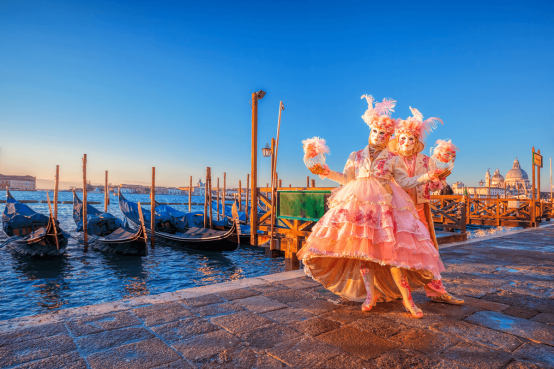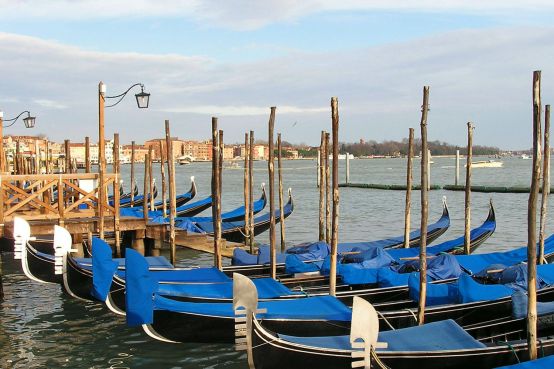Masks from the ‘Commedia dell'Arte' (artistic comedy company who improvised on stage) invaded the city. This is how the carnival began, involving a mixture of theatre and piazza. Anonymity guaranteed and no possibility of being recognised by historical costumes, intriguing black masks and aristocratic capes. The Black cloak (tabarro), a three pointed felt hat (tricorno) a typical Venetian mask (bautà) , a hood made of silk, velvet or lace ensuring that everyone look the same.
Originally carnival began 26th December in St Mark's square, whilst in the 700's it was the lasted from the first Sunday in October until Christmas and then carried on again after epiphany until lent. The opening night began within the seven theatres of Venice (no other European city has so many) whilst the spectators were all masked.
By the 700's masked Venice had become a tourist attraction. The poet Wolfgang Goethe loved being amongst the celebrations but not wanting to spend money on a costume declared to be ugly enough to look like a mask of himself. Whilst his father Johann Kaspar criticized the Venetians for their excesses which were permitted during carnival time. Casanova loved to dress up as Pierrot dancing with the court ladies.
The arrival of Napolean, marked the end of the republic as well as the carnival. The gentlemen of Venice took off their masks in order to adapt to the traditions of the Austrian domination with practices such as the waltz. After 2 centuries, in 1980, the carnival re-exploded.
The carnival lasts for at least 10 days and parties are organised in most of the squares. The ‘volo della colombina', the flight of a mechanical bird down the bell tower in St Mark's square marks the start. Street entertainers and theatrical shows are arranged in campo Santa Margherita and Sant'Angelo.
Stages are set up in San Barnaba near the university for musical concerts. Market stalls selling masks as well as refreshments such as ‘frittelle' and mulled wine are found in Campo Santo Stefano. For the last Saturday the procession of boats wind their way along the grand canal. Whilst in St Mark's square there are always make up artists for face painting. However the mask is no longer to hide behind, it is now a means of being noticed.
Arlecchino famous mask known all over the world for it's multicoloured diamond shaped costume.
Pulcinella with it's cone shaped hat and beak shaped mask.
Costumes from the 18th Century are widely used during the carnival, reflecting the age of decadence the carnival seems to evoke in the minds of most visitors to the city. The best times to attend the Carnival are the first few days and the last two days when there are more public celebrations and festivities.
In between these times the main entertain is watching wealthy people parade in period costumes that cost a small fortune to rent. The Carnival is dying a slow death as the funds needed to make this a special event never seem to be forthcoming!










